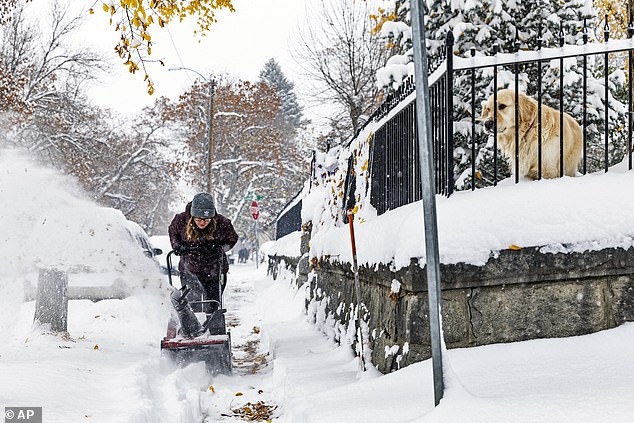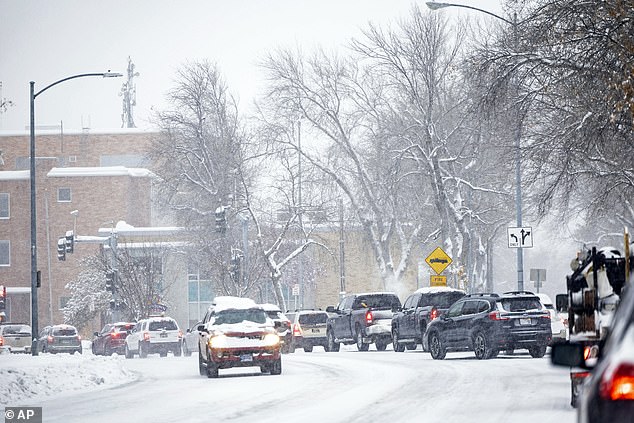The first major snowstorm of the year hits Montana, with residents clearing a foot of sidewalks and schools canceling bus routes
An early-season winter blast brought a foot of snow to Montana on Wednesday, canceling school buses and sending residents to their shovels.
With the storm moving eastward, much of the country can expect a wintry blast in the coming days before the calendar even turns to November.
Winter Storm Archer reportedly brought 10 inches of snow to central Montana, a foot in Helena, while other areas along the Rocky Mountain Front saw 6 to 8 inches of snow.
A second wave of snow will hit the area this evening, with the National Weather Service predicting total snowfall of 6 to 12 inches in eastern Montana and western North Dakota.
Winter Storm Warnings, Winter Storm Watches and Winter Weather Advisories are in effect through Thursday, impacting more than 2.7 million Americans. Fox again.
A woman clears snow in Helena, Montana, as the first major winter storm of the season dropped more than a foot of snow on the area
The National Weather Service said heavy snowfall up to an inch per hour and snow-covered, icy roads will make for difficult travel conditions.
“Roads may be snow-covered and slick in the Cascades, northern Rockies and northern Plains through Thursday,” according to Weather.com
“That includes portions of Interstates 15, 25, 90 and 94. Particularly treacherous travel is possible over mountain passes.”
According to plow truck drivers for Bozeman, Montana, they were on the road early Wednesday morning NBC Montana.
“We like to get the snow cleared all the way around the sides so people can go to and from work and do what they want to do. As well as people who visit our city. We want them to say, ‘Hey, it’s easier to get around here,'” said John Van Delinder, street inspector for the city of Bozeman.
There is a chance of 1 to 2 feet of snow in the Cascades from Northern Washington through the Northern Rockies.
“Some snow is expected to mix with rain in the interior Northwest and northern Great Basin, but accumulations here should be limited,” the National Weather Service said.
The snow in Helena led to school buses canceling their routes and residents scrambling to clear the streets of the wintry mix.
Montana residents shared videos of their homes covered in snow on TikTok.
“So I know we live in Montana, but I don’t think I was fully mentally prepared for this,” one user said.
‘A little bit of snow here today. That’s how much it snowed last night, October, in Montana,” said a user named Rock Nichols.
Eastern North Dakota and northwestern Minnesota could see several inches of snow on Friday.
The National Weather Service said, “In addition to the heavy snow, a winter blast will follow the cold front moving southward across the northern Rockies and Plains, with these frigid temperatures extending southeastward by the end of the week.”
AccuWeather predicts snow will spread south and east into part of the central Rockies and Plains on Thursday.

A person clears a snow-covered sidewalk in Montana. A second wave of snow will move across the area during the night from Wednesday to Thursday

Snow-covered roads in Montana. The National Weather Service said heavy snowfall up to an inch per hour and snow-covered, icy roads will make for difficult travel conditions.
Some rain is expected to fall in parts of the Northern Plains on Tuesday and Wednesday before snow falls, leading to hazardous road conditions.
“As temperatures drop well below freezing later in the week, this could lead to freezing issues and slick spots on roads and highways,” said AccuWeather meteorologist Joseph Bauer.
The Arctic chill after the storm will be even more frigid, AccuWeather warns.
“In the aftermath of this storm, an Arctic air mass will usher in the coldest air of the season,” Bauer said.
“Montana and Wyoming can expect temperatures 15 to 35 degrees below the historical average Thursday evening.”
